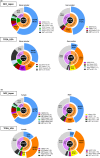Gene aberrations for precision medicine against lung adenocarcinoma
- PMID: 27027665
- PMCID: PMC4968599
- DOI: 10.1111/cas.12941
Gene aberrations for precision medicine against lung adenocarcinoma
Abstract
Lung adenocarcinoma (LADC), the most frequent histological type of lung cancer, is often triggered by an aberration in a driver oncogene in tumor cells. Examples of such aberrations are EGFR mutation and ALK fusion. Lung adenocarcinoma harboring such mutations can be treated with anticancer drugs that target the aberrant gene products. Additional oncogene aberrations, including RET, ROS1, and NRG1 fusions, skipping of exon 14 of MET, and mutations in BRAF, HER2, NF1, and MEK1, were recently added to the list of such "druggable" driver oncogene aberrations, and their responses to targeted therapies are currently being evaluated in clinical trials. However, approximately 30% and 50% of LADCs in patients in Japan and Europe/USA, respectively, lack the driver oncogene aberrations listed above. Therefore, novel therapeutic strategies, such as those that exploit the vulnerabilities of cancer cells with non-oncogene aberrations, are urgently required. This review summarizes the current status of research on precision medicine against LADC and enumerates the research priorities for the near future.
Keywords: Chromatin remodeling genes; driver oncogene aberration; gene fusion; molecular targeting therapy; smoking.
© 2016 The Authors. Cancer Science published by John Wiley & Sons Australia, Ltd on behalf of Japanese Cancer Association.
Figures





References
-
- Sun S, Schiller JH, Gazdar AF. Lung cancer in never smokers–a different disease. Nat Rev Cancer 2007; 7: 778–90. - PubMed
-
- Toh CK, Gao F, Lim WT, et al Never‐smokers with lung cancer: epidemiologic evidence of a distinct disease entity. J Clin Oncol 2006; 24: 2245–51. - PubMed
-
- Pasche B, Grant SC. Non‐small cell lung cancer and precision medicine: a model for the incorporation of genomic features into clinical trial design. JAMA 2014; 311: 1975–6. - PubMed
-
- Jonkers J, Berns A. Oncogene addiction: sometimes a temporary slavery. Cancer Cell 2004; 6: 535–8. - PubMed
Publication types
MeSH terms
Substances
LinkOut - more resources
Full Text Sources
Other Literature Sources
Medical
Research Materials
Miscellaneous

